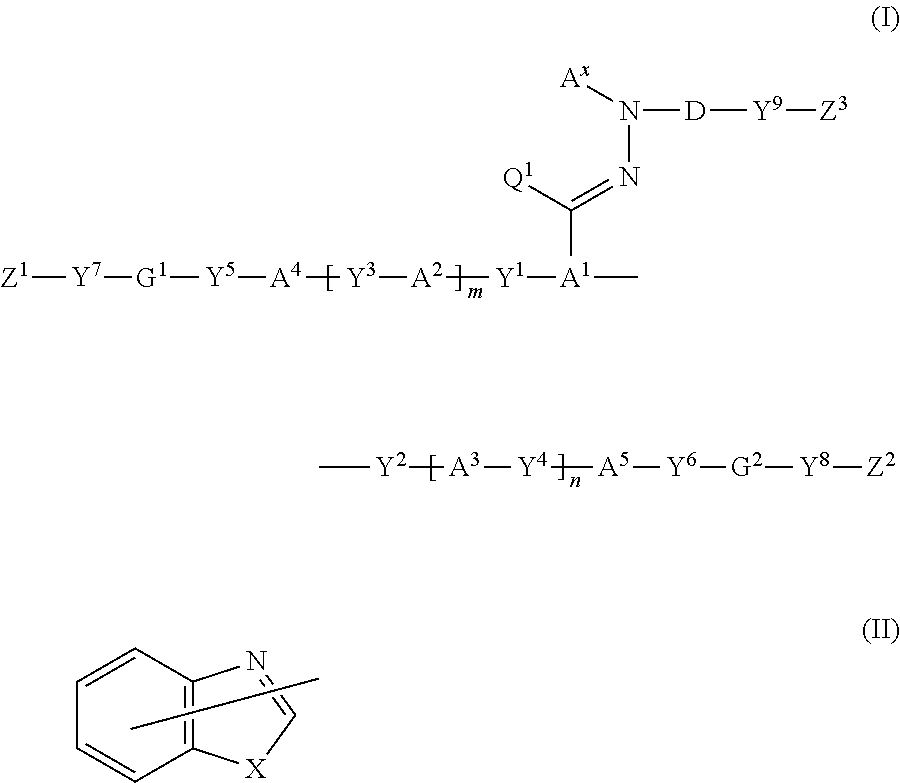Polymerizable compound, polymerizable composition, polymer, and optically anisotropic product
- Summary
- Abstract
- Description
- Claims
- Application Information
AI Technical Summary
Benefits of technology
Problems solved by technology
Method used
Image
Examples
example 1
Synthesis of Compound 1
[0207]
Step 1: Synthesis of Intermediate A
[0208]
[0209]A four-necked reactor equipped with a thermometer was charged with 8.01 g (105 mmol) of 2-hydrazinoethanol and 30 ml of 2-propanol under a nitrogen stream to prepare a solution. After the addition of 2.00 g (11.8 mmol) of 2-chlorobenzothiazole to the solution, the mixture was refluxed for 3 hours. After completion of the reaction, the reaction mixture was cooled to 25° C., and added to 300 ml of water, followed by extraction with 500 ml of ethyl acetate. The ethyl acetate layer was dried over anhydrous sodium sulfate, and sodium sulfate was filtered off. Ethyl acetate was evaporated from the filtrate under reduced pressure using a rotary evaporator to obtain a white solid. The white solid was recrystallized from ethyl acetate to obtain 0.9 g of an intermediate A (yield: 35.8%).
[0210]The structure of the target product was identified by 1H-NMR.
[0211]1H-NMR (500 MHz, DMSO-d6, TMS, δ ppm): 7.66 (dd, 1H, J=1.0 H...
example 2
Synthesis of Compound 2
[0228]
Step 1: Synthesis of Intermediate E
[0229]
[0230]A four-necked reactor equipped with a thermometer was charged with 20 g (144.8 mmol) of 2,5-dihydroxybenzaldehyde, 105.8 g (362.0 mmol) of 4-(6-acryloylhex-1-yloxy)benzoic acid (manufactured by DKSH Japan K.K.), 5.3 g (43.4 mmol) of 4-(dimethylamino)pyridine, and 200 ml of N-methylpyrrolidone under a nitrogen stream to prepare a homogeneous solution. After the addition of 83.3 g (434.4 mol) of 1-ethyl-3-(3-dimethylaminopropyl)carbodiimide hydrochloride (WSC) to the solution, the mixture was stirred at 25° C. for 12 hours. After completion of the reaction, the reaction mixture was added to 1.5 l of water, followed by extraction with 500 ml of ethyl acetate. The ethyl acetate layer was dried over anhydrous sodium sulfate, and sodium sulfate was filtered off. Ethyl acetate was evaporated from the filtrate under reduced pressure using a rotary evaporator to obtain a light yellow solid. The light yellow solid was...
example 3
[0251]1.0 g of the compound 1 obtained in Example 1, 30 mg of a photoinitiator (“Irgacure 379EG” manufactured by BASF), and 100 mg of a 1% cyclopentanone solution of a surfactant (“KH-40” manufactured by AGC Seimi Chemical Co., Ltd.) were dissolved in 2.3 g of cyclopentanone. The solution was filtered through a disposable filter having a pore size of 0.45 μm to prepare a polymerizable composition 1.
PUM
| Property | Measurement | Unit |
|---|---|---|
| Antireflective | aaaaa | aaaaa |
| Anisotropy | aaaaa | aaaaa |
| Optical properties | aaaaa | aaaaa |
Abstract
Description
Claims
Application Information
 Login to View More
Login to View More - R&D
- Intellectual Property
- Life Sciences
- Materials
- Tech Scout
- Unparalleled Data Quality
- Higher Quality Content
- 60% Fewer Hallucinations
Browse by: Latest US Patents, China's latest patents, Technical Efficacy Thesaurus, Application Domain, Technology Topic, Popular Technical Reports.
© 2025 PatSnap. All rights reserved.Legal|Privacy policy|Modern Slavery Act Transparency Statement|Sitemap|About US| Contact US: help@patsnap.com



